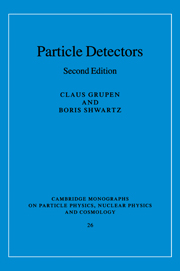Book contents
- Frontmatter
- Contents
- Preface to the second edition
- Preface to the first edition
- Introduction
- 1 Interactions of particles and radiation with matter
- 2 Characteristic properties of detectors
- 3 Units of radiation measurements and radiation sources
- 4 Accelerators
- 5 Main physical phenomena used for particle detection and basic counter types
- 6 Historical track detectors
- 7 Track detectors
- 8 Calorimetry
- 9 Particle identification
- 10 Neutrino detectors
- 11 Momentum measurement and muon detection
- 12 Ageing and radiation effects
- 13 Example of a general-purpose detector: Belle
- 14 Electronics
- 15 Data analysis
- 16 Applications of particle detectors outside particle physics
- Résumé
- 17 Glossary
- 18 Solutions
- Appendix 1 Table of fundamental physical constants
- Appendix 2 Definition and conversion of physical units
- Appendix 3 Properties of pure and composite materials
- Appendix 4 Monte Carlo event generators
- Appendix 5 Decay-level schemes
- Index
6 - Historical track detectors
Published online by Cambridge University Press: 19 October 2009
- Frontmatter
- Contents
- Preface to the second edition
- Preface to the first edition
- Introduction
- 1 Interactions of particles and radiation with matter
- 2 Characteristic properties of detectors
- 3 Units of radiation measurements and radiation sources
- 4 Accelerators
- 5 Main physical phenomena used for particle detection and basic counter types
- 6 Historical track detectors
- 7 Track detectors
- 8 Calorimetry
- 9 Particle identification
- 10 Neutrino detectors
- 11 Momentum measurement and muon detection
- 12 Ageing and radiation effects
- 13 Example of a general-purpose detector: Belle
- 14 Electronics
- 15 Data analysis
- 16 Applications of particle detectors outside particle physics
- Résumé
- 17 Glossary
- 18 Solutions
- Appendix 1 Table of fundamental physical constants
- Appendix 2 Definition and conversion of physical units
- Appendix 3 Properties of pure and composite materials
- Appendix 4 Monte Carlo event generators
- Appendix 5 Decay-level schemes
- Index
Summary
A man should look for what is, and not for what he thinks should be.
Albert EinsteinIn this chapter some historical particle detectors will be briefly described. These are mainly optical devices that have been used in the early days of cosmic rays and particle physics. Even though some of these detectors have been ‘recycled’ for recent elementary particle physics experiments, like nuclear emulsions for the discovery of the tau neutrino (vT) or bubble chambers with holographic readout for the measurement of shortlived hadrons, these optical devices are nowadays mainly integrated into demonstration experiments in exhibitions or employed as eye-catchers in lobbies of physics institutes (like spark chambers or diffusion cloud chambers).
Cloud chambers
The cloud chamber (‘Wilson chamber’) is one of the oldest detectors for track and ionisation measurement [1–4]. In 1932 Anderson discovered the positron in cosmic rays by operating a cloud chamber in a strong magnetic field (2.5 T). Five years later Anderson, together with Neddermeyer, discovered the muon again in a cosmic-ray experiment with cloud chambers.
A cloud chamber is a container filled with a gas–vapour mixture (e.g. air–water vapour, argon–alcohol) at the vapour saturation pressure. If a charged particle traverses the cloud chamber, it produces an ionisation trail.
- Type
- Chapter
- Information
- Particle Detectors , pp. 160 - 185Publisher: Cambridge University PressPrint publication year: 2008
- 1
- Cited by

